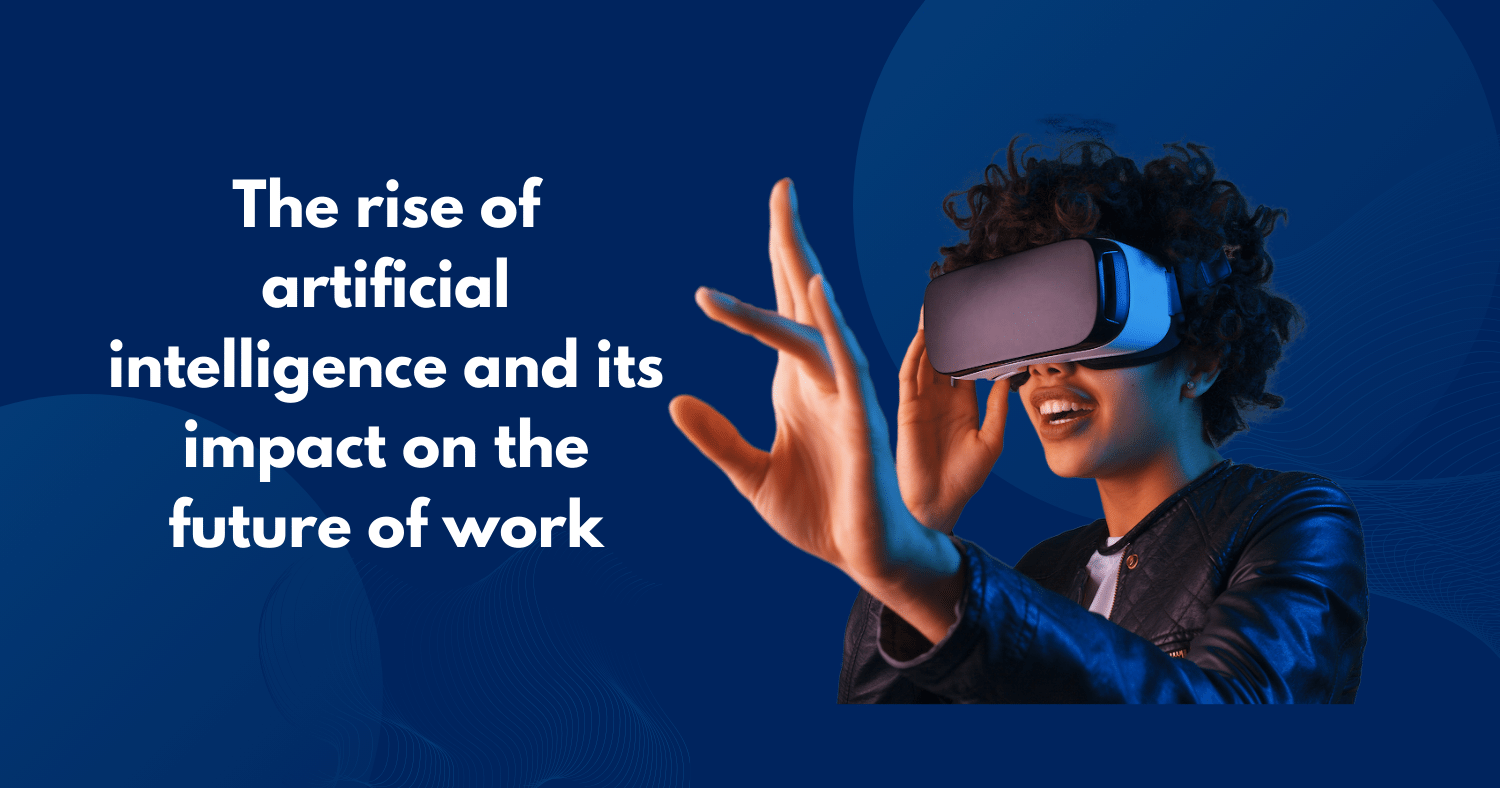The rise of artificial intelligence and its impact on the future of work
It is noteworthy that artificial intelligence (AI) is expected to have a substantial impact on the labor market during the next several years, affecting 80–90 million workers globally. It is anticipated that as AI develops and becomes more sophisticated, many repetitive and routine tasks will be automated, which may result in employment losses in several industries. But there are also new career prospects emerging, especially in the fields of technology, engineering, and data science, as well as artificial intelligence. To stay competitive, people and organizations must keep up with these developments and adjust to the changing nature of the labor market.
Technological developments in AI
Artificial intelligence is developing at a never-before-seen pace, with new uses being created daily. Machine learning, which enables computers to learn and grow from experience without being explicitly programmed, is one of the most important fields of development. In the workplace, this technology is already being utilized for a number of purposes, including predictive maintenance, fraud detection, and customer support. For instance, while some businesses use machine learning algorithms to analyze data and forecast future trends, others utilize chatbots driven by AI to answer customer questions and support complaints.
Employing AI in the workplace has many advantages. Enhanced efficiency and productivity rank among the biggest benefits. Employees can focus on more intricate and creative work by using AI-powered solutions to automate time-consuming and repetitive chores. This may result in reduced expenses, better-quality output, and quicker turnaround times. AI may also assist in finding patterns and insights in data that humans might overlook, which improves forecast accuracy and decision-making. In general, artificial intelligence (AI) has the potential to completely transform the way we work and increase corporate competitiveness in the global economy.
Prediction about AI
AI technology is predicted to have a big impact on the labor market as it develops and becomes more sophisticated. Automation may cause certain occupations to become obsolete, but it’s also creating new employment as AI is used more frequently. AI’s effects on the labor market are a complicated matter that has to be carefully considered.
Automation’s replacement of specific jobs is one of AI’s main implications on the labor market. For instance, manual or repetitive professions like data entry, assembly line labor, and regular customer service are especially susceptible to automation. But AI is also generating new employment prospects, especially in fields like software development, data analysis, and AI research.
The need for people with expertise in data science and artificial intelligence is another way that AI is transforming the employment landscape. Workers must be well-versed in AI’s features and capabilities in order to use it effectively. Because of this, there is a greater need for people with expertise in fields like machine learning, programming, and data analysis.
AI will have a huge impact on the labor market; over the next few years, it is expected to affect 80–90 million workers globally, forcing some of them to find new employment. It is anticipated that as AI develops and becomes more sophisticated, many repetitive and routine tasks will be automated, which may result in employment losses in several industries. But there are also new career prospects emerging, especially in data science and artificial intelligence-related fields. The need for AI-related occupations is expected to expand significantly in some businesses, like healthcare and finance, while automation may result in more job losses in other industries. To stay competitive, people and organizations must keep up with these developments and adjust to the changing nature of the labor market.
Getting Ready for the Future
AI technology is revolutionizing the workplace, and people and organizations need to be ready for the changes it will bring about. Focusing on acquiring new abilities that are pertinent to the evolving labor market is one strategy to get ready. This comprises programming, machine learning, and data analysis abilities. Furthermore, it is critical to develop abilities like creativity, problem-solving, and emotional intelligence that are challenging for robots to emulate. As AI takes on more repetitive and routine work, these talents will become more and more in demand.
Businesses can also invest in training programs and reskill their staff to get ready for the changes that artificial intelligence will bring about. Employees will benefit from this as they acquire the skills necessary to use AI productively and adjust to a changing labor market. In addition, companies should investigate innovative work arrangements like job-sharing or flexible work schedules to give staff members the chance to grow professionally and maintain their competitive edge in the labor market.
By reading industry reports, attending conferences and workshops, and networking with other professionals in the area, individuals and businesses can also stay up-to-date on the newest trends and advancements in artificial intelligence. They will be able to stay ahead of the curve and adjust to changes as they happen, thanks to this.
Proactive learning and growth are necessary to get ready for the changes that artificial intelligence will bring about. People and companies can prosper in the AI era and remain competitive in the shifting labor market by learning new skills, funding training initiatives, and keeping up with industry advancements.
AI is predicted to have a big impact on employment in the future and is already revolutionizing the workplace. As this article explains, developments in AI technology, adjustments in the labor market, and future-focused policies all emphasize how important it is for people and businesses to adjust to the changing nature of work. Automation may result in the loss of certain employment, but it will also provide new opportunities, so it’s critical to concentrate on acquiring skills that are relevant to the shifting labor market. While individuals should stay educated and look for opportunities to learn and grow, businesses can invest in training programs and experiment with innovative work arrangements. In the end, how we respond to these developments and take advantage of the opportunities they present will determine how AI affects the nature of employment in the future.
We can all agree that artificial intelligence (AI) is one of the most important technologies of our day, even though nobody knows how it will affect the nature of employment in the future.
Artificial intelligence already permeates every aspect of our daily lives, impacting everything from our shopping habits to our online dating prospects and search engine results. Data indicates that within the past four years, the use of AI has expanded by 270% in a number of commercial areas.
The growth of AI and robotics
In the sixteenth century, working by hand was commonplace. until a clergyman by the name of William Lee had the idea of automating the process of creating stockings, at least partially. He altered carpet-making looms to produce a lengthy stocking material sheet that could be cut and sewn into stockings. Compared to the usual technique, it was significantly faster and less expensive.
Legend has it that Queen Elizabeth I turned down Lee’s application for a patent on his device because she was worried about what would happen to the former stocking knitters who would no longer have a job. Although his invention had little effect, it laid the groundwork for later advancements in textile machines.
Revolutions in textiles in the 1800s
English textile workers faced even more significant shifts hundreds of years later. They were not the only ones.
As the Industrial Revolution gained momentum, people began to migrate from rural areas to the new, rapidly expanding metropolis. They were employed in factories and mills where the output of handcrafted goods had hit previously unheard-of levels thanks to steam-powered technology.
Farmworkers also faced challenges due to mechanization. The demand for machines to do tasks like planting seeds and harvesting crops grew as the world’s population expanded. Reactions among working people were not always positive. The Luddites were a movement in the UK that opposed the growing use of automation.
Welding and spray painting were two of the first assembly-line tasks that robots replaced. There were people there to oversee the machinery.
The list of tasks that robots can currently carry out has expanded as technology has developed to encompass increasingly complex operations like fixing car windshields. They’re also frequently utilized to move big, heavy items in manufacturing.
The Effects of Artificial Intelligence on Work in the Future
The trend to replace people with machinery is growing as businesses look to reduce COVID-19 infections in the workplace while maintaining low operating costs. The shift in business operations from a survival mode to a pandemic contingency plan may accelerate the replacement of human workers with computers. In a recent study, economists Daron Acemoglu from Boston University and MIT predicted that by 2025, robots would replace two million more workers in the industrial sector alone. The use of AI in manufacturing is growing in importance as businesses look to reduce operating expenses by having machines take the place of employees.
Among the 15 jobs most at risk from automation are cashiers, food service employees, and customer service representatives, all of which employ a large number of black and Latino Americans, according to McKinsey. By 2030, the United States may lose 73 million workers as a result of their unrelenting march.
Our lives are changing quickly due to artificial intelligence (AI), and the workplace of the future is no different. It will have a big influence and present both chances and challenges. The following is a summary of what to expect:
Possibility of Job Loss:
Automation driven by AI is expected to replace routine, repetitive tasks in a variety of industries. Particularly vulnerable are jobs in manufacturing, data entry, and customer service that have clear protocols.
Changes in Employment:
As AI replaces human labor in certain areas, many jobs will change. In order to effectively engage with AI and manage more complicated, non-routine aspects of their jobs, workers will need to acquire new skills.
New Job Creation:
Additionally, AI will generate whole new work roles. Jobs involving the development and upkeep of AI systems, cybersecurity, data science, and AI specialists will all be in great demand.
Total Effect:
There is much disagreement over how much AI will replace jobs. Some fear there will be widespread unemployment, while others think there will be new chances. The ability to adapt and learn continuously will be crucial.
Here are a few strategies to get ready for the workplace of the future:
- Develop transferable skills: In an AI-powered workplace, abilities like critical thinking, problem-solving, creativity, and communication will be essential.
- Accept lifelong education: keep abreast of current developments in technology and be prepared to pick up new skills when employment demands change.
- Make an investment in AI knowledge. Recognize the workings of AI and how it might affect your industry. This will enable you to adjust and take advantage of AI.
- Educational establishments and governments both have a part to play.
Invest in programs for retraining. Give employees the tools they need to succeed in the AI economy.
Establish guidelines for AI adoption: Make sure the shift to an AI-powered workforce is seamless and takes ethical concerns into account. As artificial intelligence advances, the future of labor will undoubtedly change. We can guarantee a future in which AI and humans collaborate to build a more productive and affluent society by embracing lifelong learning, acquiring the necessary skills, and being flexible.




